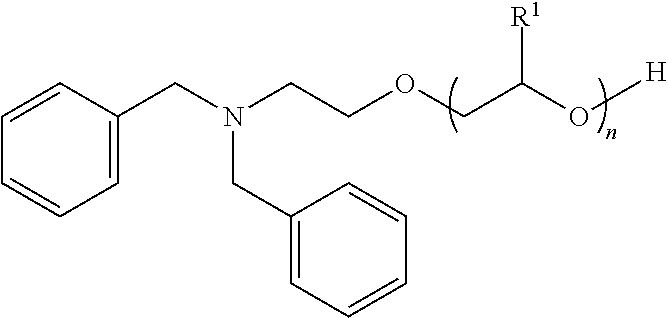Dibenzylamine hydrophobe
a technology of dibenzylamine and hydrophobic compounds, applied in the field of dibenzylamine hydrophobic compounds, can solve problems such as poor formulation
- Summary
- Abstract
- Description
- Claims
- Application Information
AI Technical Summary
Benefits of technology
Problems solved by technology
Method used
Image
Examples
example 1
Preparation of HEUR Polymer Based on Intermediate 1
[0026]CARBOWAX™ 8000 Polyethylene Glycol (A trademark of the Dow Chemical Company or Its Affiliates, molecular weight 8200; 1539.1 g) was heated to 110° C. in vacuo in a batch melt reactor for 2 h. Butylated hydroxyl toluene (BHT, 0.191 g) was then added and mixed for 5 min. Desmodur W H12-MDI (108.19 g) was then added to the reactor with mixing for 5 min Bismuth octoate solution (28%, 3.85 g) was then added to the reactor and the temperature of the mixture was maintained at 110° C. with stirring for 10 min Intermediate I (258.16 g) was then added to the reactor and the temperature was maintained at 110° C. with stirring for 10 min. The resulting molten polymer was removed from the reactor and cooled.
PUM
| Property | Measurement | Unit |
|---|---|---|
| diameter | aaaaa | aaaaa |
| temperature | aaaaa | aaaaa |
| temperature | aaaaa | aaaaa |
Abstract
Description
Claims
Application Information
 Login to View More
Login to View More - R&D
- Intellectual Property
- Life Sciences
- Materials
- Tech Scout
- Unparalleled Data Quality
- Higher Quality Content
- 60% Fewer Hallucinations
Browse by: Latest US Patents, China's latest patents, Technical Efficacy Thesaurus, Application Domain, Technology Topic, Popular Technical Reports.
© 2025 PatSnap. All rights reserved.Legal|Privacy policy|Modern Slavery Act Transparency Statement|Sitemap|About US| Contact US: help@patsnap.com



